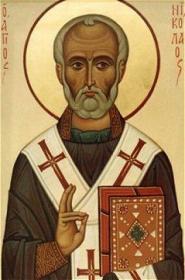Saint Nicholas
Jaroslav Čermák (1831 - 1878) - Sv. Mikuláš.jpg
Full-length icon of Saint Nicholas by Jaroslav Čermák, showing him with a halo, dressed in clerical garb, and holding a book of the scriptures in his left hand while making the hand gesture for the sign of the cross with his right.
Defender of Orthodoxy, Wonderworker, Holy Hierarch, Bishop of Myra
Born Traditionally 15 March 270[1]
Patara, Roman Empire
Died Traditionally 6 December 343 (aged 73)
Myra, Roman Empire
Venerated in Anglicanism, Baptist, Catholicism, Eastern Orthodoxy, Oriental Orthodoxy, Lutheranism, Methodism, Reformed
Major shrine Basilica di San Nicola, Bari, Italy
Feast 19 December [O.S. 6 December] (main feast day – Saint Nicholas Day)
22 May [O.S. 9 May] (translation of relics)[2]
Attributes Vested as a Bishop. In Eastern Christianity, wearing an omophorion and holding a Gospel Book. Sometimes shown with Jesus Christ over one shoulder, holding a Gospel Book, and with the Theotokos over the other shoulder, holding an omophorion
Patronage Children, coopers, sailors, fishermen, merchants, broadcasters, the falsely accused, repentant thieves, brewers, pharmacists, archers, pawnbrokers, Aberdeen, Galway, Russia, Greece, Hellenic Navy, Liverpool, Bari, Siggiewi, Moscow, Amsterdam, Lorraine and Duchy of Lorraine
Saint Nicholas of Myra[a] (traditionally 15 March 270 – 6 December 343),[3][4] also known as Nicholas of Bari, was an early Christian bishop of the ancient Greek city of Myra in Asia Minor (modern-day Demre, Turkey) during the time of the Roman Empire.[7] He is revered by many Christians as a saint.[8] Because of the many miracles attributed to his intercession, he is also known as Nicholas the Wonderworker.

